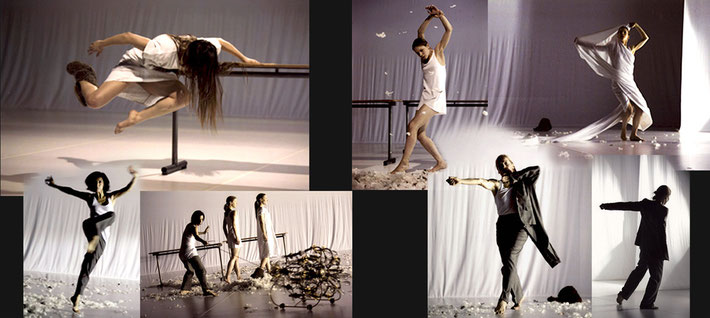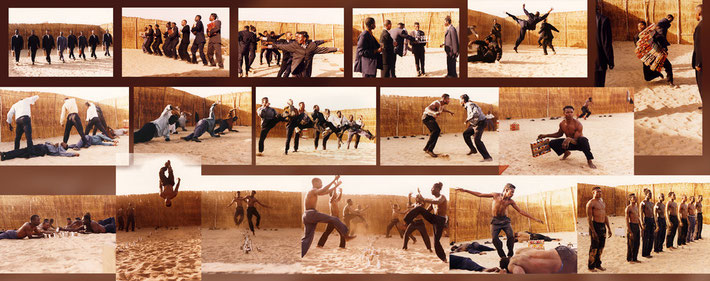PRESS REVIEWS: GENERAL CRITICS
Vittoria Ottolenghi, Rom, Paese Sera, April 14th 1982
After "Frauen", Susanne Linke presents herself in a solo, "Im Bade wannen", to music by E. Satie.
Sometimes one shouldn´t be afraid of certain words. To put it loud and clear: this is a true masterpiece. It is the danced interior monologue of someone who - like Joyce´s Ulysses - is alone and free (even if this involuntary loneliness and freedom has a frightened side to it); however, this only takes place in her own bathroom. When she looks herself in, possibly a result of a necessitiy that nature forces us to recognize, her soul takes a short, radiant detour into the mysterious realm of loneliness. And see there: even the bathroom inhabitant becomes a wonderfully understandable entity, almost an object that one can polish to a shine to the point of dissolving, a memory of a mother´s breast. The whisper of long lost, impossible happiness is perfect.
(see: "Im Bade wannen", solo, premiere 1980)
Gabriele Brandstetter, "Über Gänge: Susanne Linkes Soli", German Dance Prize laudatio 2007
The choreographer and dancer Susanne Linke calls learning to walk one of the essential motivations on her way to dance. When she talks about her childhood, speech defects and the associated difficulties of making herself understood, she says: "It was a slow, difficult learning to walk." A repeated learning to walk is also the subject of her solo "Schritte verfolgen" 1985. It is a piece about the path to finding herself. The attempts at finding "Schritte" [steps] meet up with obstacles: they are paths and attempts at walking in transitions. "Learning to walk," says Susanne Linke, "that´s my focus in this piece. It´s about developments, the duality of life, and that you are constantly wandering along the adge of a chasm. You can fall down and have to struggle back up. It´s about the existential battle, about the battle of not falling from the path, of securing your steps and developing a series of steps."
With this piece, the choreographer follows her own path back into her childhood. She composes theses experiences in a series of extremely dynamic movements that make both the breaks and the u-turns of struggle and suffering visible. In the first part of the solo, the dancer runs against a table with an irritating vehemence, bounces back, repeats her attack of the obstacle until exhaustion sets in - until the limitation is overcome and she literally arrives at a different level. But a psychological barrier follows after the physical one: she takes up the challenge of personal possibilities and the limits of movement - in the confrontation with a dance ideal of the body and its movement. Susanne Linke follows the path of a dancer - from the imitation of ballet poses, up to actually finding an individual identity in movement: taking steps with an idiosyncratic and nonconformist beauty.
You can understand this solo, "Schritte verfolgen", which she has often performed and recently - over 20 years later - presents like a legacy, to be the centerpiece of Susanne Linke´s solo career.
(see: "Schritte verfolgen", reconstruction-premiere 2007, CHOREOGRAPHIES)
Katja Schneider, Continuations and Variations
... "Le Coq est mort"
The latter was created on Germaine Acogny´s suggestion with the dancers of her company Jant-Bi in cooperation with Avi Kaiser in Toubab Dialaw Senegal. "It was supposed to be a typical dance theater piece, with African men who start as diplomats with briefcases and champagne glasses and end up as Africans again," says Susanne Linke. Cliché ideas of Africa quickly threw the choreographer into the hot sand in which the piece was rehearsed and created together. "You habe to be completely open, somethong only develops when you meet." Being amazed and learning was in the forefront first. African and European dance clashed in "Le Coq est mort", and thus three concepts of movement: classical dance and modern from Europe that Susanne Linke had learned confronted African dance.
For the choreographer these were two foreign idioms: "The world of classical dance is still very foreign to me. The nobility, the representive character, the emphasis on the lines. It is still very foreign to me," she says and bridges to African dance over her dance training with Mary Wigman: She is fascinated by its energy.
"Thanks to Mary Wigman, who concentrated very strongly on the center and used the torso, from which everything
originates, from the hips and stomach over the back. Thanks to this school, access to African dance was somewhat easier."
(see: "Le Coq est mort", premiere 1999, CHOREOGRAPHIES)
Irene Sieben, Susanne Linke
As a solitaire she (Susanne Linke) belongs to an endangered species. Combined in Susanne Linke is not only the legacy of German Expressionist dance as handed dowm by Mary Wigman and Kurt Jooss, but also that of German Dance Theater, a genre she herself invented. Inspired by Dore Hoyer´s poignant presence and form-giving emotionality, Susanne Linke followed the path even further and developed dance as an existential art form. She distrusted concepts. What has mattered most for her is "this aura of something", and the palpable and visible energy and sensuality of her body in space and time, born from a unity composed of body, soul and spirit. Mary Wigman passed on to her the sense that a dancer´s body is only then transparent and porous when dance enlivens it from within.
This high level of demanded quality exists in all her solos, duets, and group dances. While passing on her 1985 autobiographical piece "Schritte verfolgen" to a group of young female dancers, she playfully trains herself for her major dance feat "Im Bade wannen". With "Kaikou" she turns her attention to the choreography "Ruhr-Ort" (1991) and once again concentrates on a strong team of men. The quartet (with Urs Dietrich, Henry Montes, and Brice Desault) developed from a solo in which animalistic and human drives transform.
(see: "Kaikou"", premiere 2011, CHOREOGRAPHIES)



